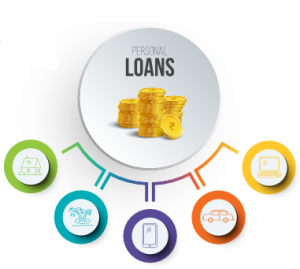Everything You Need to Know About Personal Loans: Types, Eligibility, and Management

Introduction
Personal loans are a versatile financial tool that can help individuals meet various needs, from consolidating debt to covering unexpected expenses or funding significant purchases. Unlike secured loans, personal loans typically do not require collateral, making them accessible to a wide range of borrowers. This comprehensive guide will explore the intricacies of personal loans, including their types, eligibility criteria, application process, interest rates, and tips for managing them effectively.
Types of Personal Loans
1. Unsecured Personal Loans
Unsecured personal loans are the most common type of personal loan. They do not require collateral, meaning borrowers do not have to put up any assets, such as a car or house, to secure the loan. Approval is based on the borrower’s creditworthiness, including their credit score, income, and debt-to-income ratio.
2. Secured Personal Loans
Secured personal loans require the borrower to provide collateral, which reduces the lender’s risk. This collateral can be in the form of a savings account, certificate of deposit (CD), or other assets. Secured loans often have lower interest rates and higher borrowing limits compared to unsecured loans, but they come with the risk of losing the collateral if the borrower defaults.
3. Fixed-Rate Personal Loans
Fixed-rate personal loans have an interest rate that remains constant throughout the loan term. This provides borrowers with predictable monthly payments, making budgeting easier. Fixed-rate loans are ideal for those who prefer stability and want to avoid the risk of rising interest rates.
4. Variable-Rate Personal Loans
Variable-rate personal loans have interest rates that can fluctuate over time based on market conditions. These loans often start with a lower interest rate compared to fixed-rate loans, but the rate can increase or decrease, affecting monthly payments. Variable-rate loans may be suitable for borrowers who expect interest rates to remain stable or decrease.
5. Debt Consolidation Loans
Debt consolidation loans are used to combine multiple debts into a single loan with a lower interest rate. This can simplify repayment and potentially reduce overall interest costs. Borrowers use the loan funds to pay off existing debts, such as credit cards, medical bills, or other high-interest loans.
6. Co-Signed Loans
A co-signed loan involves a second person, typically with better credit, who agrees to repay the loan if the primary borrower defaults. This can help individuals with poor or limited credit history qualify for a loan and secure better terms. However, both the borrower and the co-signer are equally responsible for the loan.
Eligibility Criteria for Personal Loans
Lenders consider several factors when determining a borrower’s eligibility for a personal loan. Understanding these criteria can help you prepare for the application process and improve your chances of approval.
1. Credit Score
Your credit score is a crucial factor in determining your eligibility for a personal loan. Most lenders require a minimum credit score of 600-650 for unsecured personal loans. A higher credit score can result in better loan terms, including lower interest rates and higher borrowing limits.
2. Income and Employment
Lenders assess your income and employment history to ensure you have a stable source of income to repay the loan. Most lenders require proof of consistent employment and may ask for pay stubs, tax returns, or bank statements. Self-employed individuals may need to provide additional documentation, such as profit-and-loss statements.
3. Debt-to-Income Ratio (DTI)
The DTI ratio compares your monthly debt payments to your gross monthly income. Lenders use this ratio to assess your ability to manage additional debt. Most lenders prefer a DTI ratio of 36% or lower, although some may accept higher ratios depending on other factors.
4. Loan Purpose
While personal loans can be used for a variety of purposes, some lenders may have restrictions on how the funds can be used. Common uses include debt consolidation, home improvement, medical expenses, and major purchases. Clearly stating your loan purpose can help lenders understand your financial situation and improve your chances of approval.

The Personal Loan Application Process
Applying for a personal loan involves several steps. Being well-prepared can help you navigate the process smoothly and increase your chances of securing favorable terms.
1. Assess Your Financial Situation
Before applying for a personal loan, evaluate your financial situation to determine how much you need to borrow and how much you can afford to repay. Consider your monthly income, expenses, existing debts, and credit score. Use online calculators to estimate your monthly payments based on different loan amounts and interest rates.
2. Shop Around for Lenders
Different lenders offer varying terms and interest rates, so it’s important to shop around and compare options. Consider traditional banks, credit unions, and online lenders. Pay attention to the annual percentage rate (APR), fees, repayment terms, and any special features or benefits.
3. Pre-Qualification
Many lenders offer pre-qualification, which allows you to check your eligibility and potential loan terms without affecting your credit score. Pre-qualification involves a soft credit check and provides an estimate of the loan amount, interest rate, and monthly payment you might qualify for.
4. Gather Documentation
Once you’ve chosen a lender, gather the necessary documentation for your application. This typically includes:
- Proof of identity (e.g., driver’s license, passport)
- Proof of income (e.g., pay stubs, tax returns, bank statements)
- Proof of residence (e.g., utility bill, lease agreement)
- Information about your debts and assets
5. Submit the Application
Complete the lender’s application form and submit the required documentation. Be honest and accurate when providing information, as discrepancies can delay the approval process or result in denial.
6. Loan Approval and Funding
If your application is approved, the lender will provide a loan agreement outlining the terms and conditions. Review the agreement carefully before signing. Once you accept the terms, the lender will disburse the funds, typically within a few days. The funds can be deposited directly into your bank account or sent via check.
Understanding Interest Rates and Fees
Interest rates and fees significantly impact the overall cost of your personal loan. It’s important to understand how they work and what factors influence them.
1. Interest Rates
Interest rates can be fixed or variable, and they represent the cost of borrowing the loan principal. Factors that influence interest rates include:
- Credit Score: Higher credit scores typically result in lower interest rates.
- Loan Term: Shorter loan terms often have lower interest rates compared to longer terms.
- Loan Amount: Larger loan amounts may have higher interest rates due to increased risk for the lender.
- Market Conditions: Economic factors, such as inflation and the Federal Reserve’s monetary policy, can impact interest rates.
2. Annual Percentage Rate (APR)
The APR includes both the interest rate and any fees associated with the loan, providing a more accurate picture of the total cost of borrowing. Comparing APRs can help you identify the most affordable loan option.
3. Fees
Lenders may charge various fees in addition to interest. Common fees include:
- Origination Fee: A fee charged for processing the loan application, typically ranging from 1% to 6% of the loan amount.
- Prepayment Penalty: A fee charged for paying off the loan early, which compensates the lender for lost interest.
- Late Payment Fee: A fee charged for missing a payment deadline.
- Application Fee: A fee charged for submitting a loan application, which may or may not be refundable.
Managing Your Personal Loan
Effectively managing your personal loan is crucial for maintaining financial stability and ensuring timely repayment. Here are some tips for managing your personal loan:
1. Create a Budget
Develop a budget that includes your monthly loan payment, as well as other expenses and financial obligations. Ensure you have enough income to cover your loan payment along with your other living expenses. Tracking your spending can help you stay on top of your finances and avoid missed payments.
2. Set Up Automatic Payments
Many lenders offer automatic payment options, which can help you avoid late payments and potential fees. Automatic payments can also help you stay on track with your repayment schedule and reduce the risk of missing a payment.
3. Make Extra Payments
If possible, consider making extra payments toward your loan principal. This can help you pay off the loan faster and reduce the total interest paid over the life of the loan. Some lenders allow biweekly payments, which can result in one extra payment per year.
4. Avoid Taking on Additional Debt
While repaying your personal loan, try to avoid taking on additional debt, which can strain your finances and make it more challenging to meet your repayment obligations. Focus on paying down your existing debt before considering new loans or credit.
5. Communicate with Your Lender
If you encounter financial difficulties and are unable to make your loan payments, communicate with your lender as soon as possible. Many lenders offer hardship programs or can work with you to modify your repayment plan. Proactively addressing issues can help you avoid default and protect your credit score.

Benefits and Drawbacks of Personal Loans
Personal loans offer several benefits, but they also come with potential drawbacks. It’s important to weigh these factors when considering whether a personal loan is the right choice for your financial needs.
Benefits
- Flexibility: Personal loans can be used for a wide range of purposes, from debt consolidation to major purchases.
- No Collateral Required: Unsecured personal loans do not require collateral, reducing the risk of losing assets.
- Fixed Payments: Fixed-rate personal loans provide predictable monthly payments, making budgeting easier.
- Debt Consolidation: Personal loans can simplify debt management by consolidating multiple debts into a single loan with a lower interest rate.
- Improve Credit Score: Successfully repaying a personal loan can improve your credit score by demonstrating responsible borrowing behavior.
